#moorish kings of granada
Text
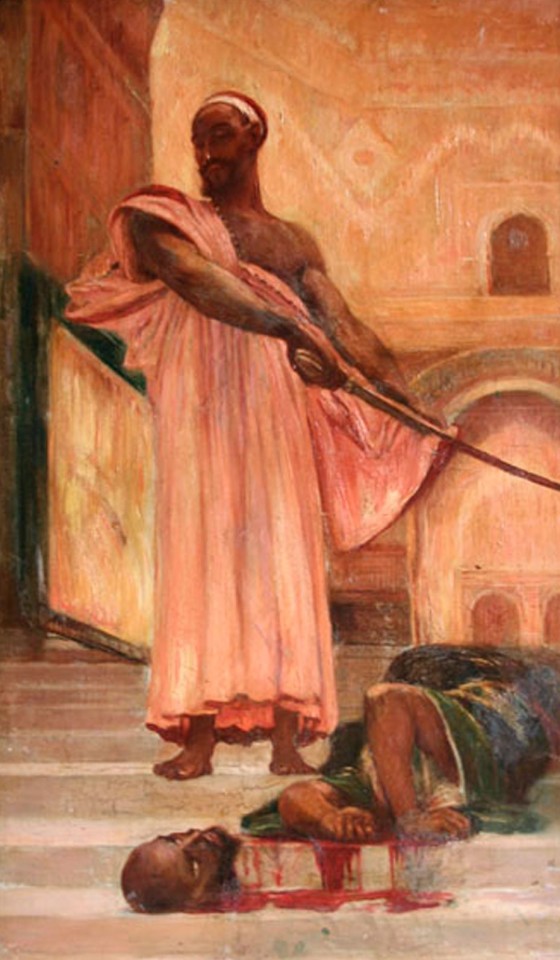
Henri regnault - Execution without Judgment under the Moorish Kings of Granada, 1870.
#Henri regnault#Execution without Judgment under the Moorish Kings of Granada#Execution#murder#dead#headless
15 notes
·
View notes
Text

WHEN BLACK-MEN RULED THE WORLD
Some Things You Did Not Know About the Moors of Spain
1. The Spanish occupation by the Moors began in 711 AD when an African army, under their leader Tariq ibn-Ziyad, crossed the Strait of Gibraltar from northern Africa and invaded the Iberian peninsula ‘Andalus’.
2. A European scholar sympathetic to the Spaniards remembered the conquest in this way:
a. The reins of the Moors horses were as fire, their faces black as pitch, their eyes shone like burning candles, their horses were swift as leopards and the riders fiercer than a wolf in a sheepfold at night . . . The noble Goths [the German rulers of Spain to whom Roderick belonged] were broken in an hour, quicker than tongue can tell. Oh luckless Spain!
Quoted in Edward Scobie, The Moors and Portugal’s Global Expansion, in Golden Age of the Moor, ed Ivan Van Sertima, US, Transaction Publishers, 1992, p.336
3. The Moors, who ruled Spain for 800 years, introduced new scientific techniques to Europe, such as an astrolabe, a device for measuring the position of the stars and planets. Scientific progress in Astronomy, Chemistry, Physics, Mathematics, Geography and Philosophy flourished in Moorish Spain.
4. Basil Davidson, one of the most noted historians recognized and declared that there were no lands at that time (the eighth century) “more admired by its neighbours, or more comfortable to live in, than a rich African civilization which took shape in Spain”
5. At its height, Córdova, the heart of Moorish territory in Spain, was the most modern city in Europe and the world. The streets were well-paved, with raised sidewalks for pedestrians. During the night, ten miles of streets were well illuminated by lamps. This was hundreds of years before there was a paved street in Paris or a street lamp in London. Cordova had 900 public baths – we are told that a poor Moor would go without bread rather than soap while the then
Queen of England never had a bath!
6. The Great Mosque of Córdoba (La Mezquita) is still one of the architectural wonders of the world in spite of later Spanish disfigurements. Its low scarlet and gold roof, supported by 1,000 columns of marble, jasper and and porphyry, was lit by thousands of brass and silver lamps which burned perfumed oil.
7. Education was universal in Moorish Spain, available to all, while in Christian Europe more than ninety-nine percent of the population were illiterate, and even kings could neither read nor write. At that time, Europe had only two universities copied from Spain, the Moors had seventeen great Universities! These were located in Almeria, Cordova, Granada, Juen, Malaga, Seville, and Toledo in which the majority of the lecturers were women.
8. In the tenth and eleventh centuries, public libraries in Europe were non-existent, while Moorish Spain could boast of more than seventy, of which the one in Cordova housed six hundred thousand manuscripts.
9. Over 4,000 Arabic words and Arabic-derived phrases have been absorbed into the Spanish language. Words beginning with “al,” for example, are derived from Arabic. Arabic words such as algebra, alcohol, chemistry, nadir, alkaline, and cipher entered the language. Even words such as checkmate, influenza, typhoon, orange, and cable can be traced back to Arabic origins.
10. The most significant Moorish musician was known as Ziryab, the Blackbird who arrived in Spain in 822. The Moors introduced earliest versions of several instruments, including the Lute or el oud, the guitar or kithara and the Lyre. Ziryab changed the style of eating by breaking meals into separate courses beginning with soup and ending with desserts.
11. The Moors introduced paper to Europe and Arabic numerals, which replaced the clumsy Roman system.
12. The Moors introduced many new crops including the orange, lemon, peach, apricot, fig, sugar cane, dates, ginger and pomegranate as well as saffron, sugar cane, cotton, silk and rice which remain some of Spain’s main products today.
13. The Moorish rulers lived in sumptuous palaces, while the monarchs of Germany, France, and England dwelt in big barns, with no windows and no chimneys, and with only a hole in the roof for the exit of smoke. One such Moorish palace ‘Alhambra’ (literally “the red one”) in Granada is one of Spain’s architectural masterpieces. Alhambra was the seat of Muslim rulers from the 13th century to the end of the 15th century. The Alhambra is a UNESCO World Heritage Site
14. It was through Africa that the new knowledge of China, India, and Arabia reached Europe. The Moors brought the Compass from China into Europe.
15. The Moors ruled and occupied Lisbon in Portugal (named “Lashbuna” by the Moors) and the rest of the country until well into the twelfth century. They were finally defeated and driven out by the forces of King Alfonso Henriques. The scene of this battle was the ‘Castle of St. George.’
Beginning in the 12th century and continuing for hundreds of years, the Inquisition was infamous for the severity of its tortures and its persecution of Jews and Muslims. Its worst manifestation was in Spain, where the Spanish Inquisition was a dominant force for more than 200 years, resulting in some 32,000 executions.
147 notes
·
View notes
Text
Саммеццано — красивейший замок Италии. Sammezzano is the most beautiful castle in Italy.



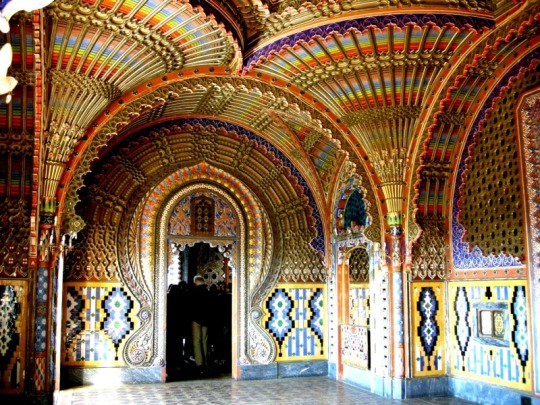
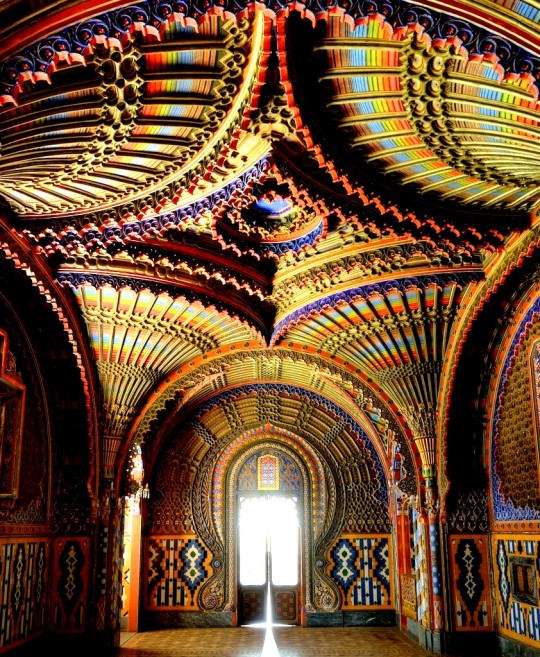


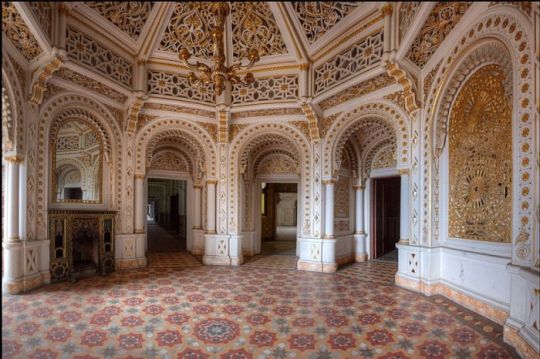
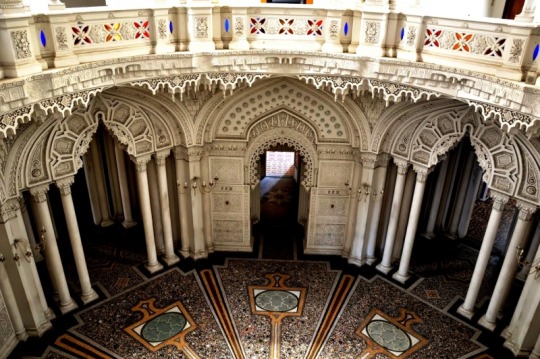



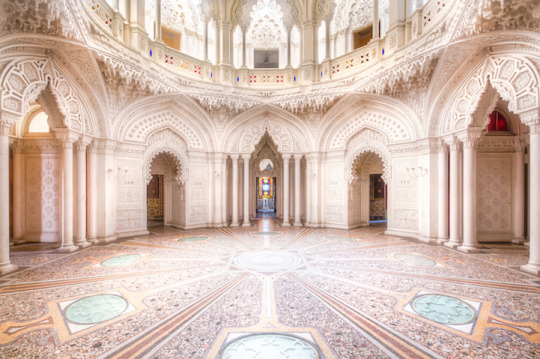
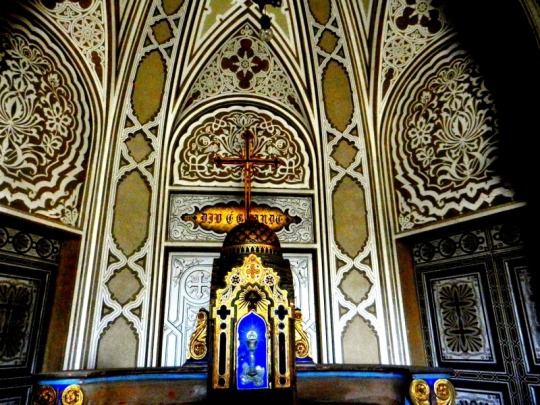



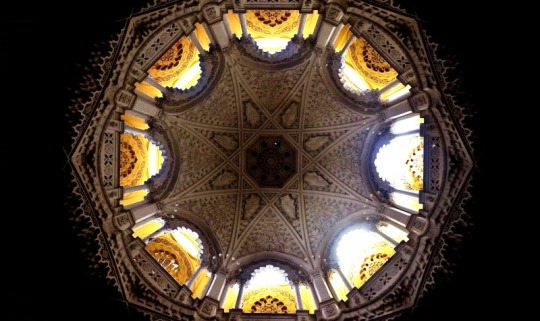
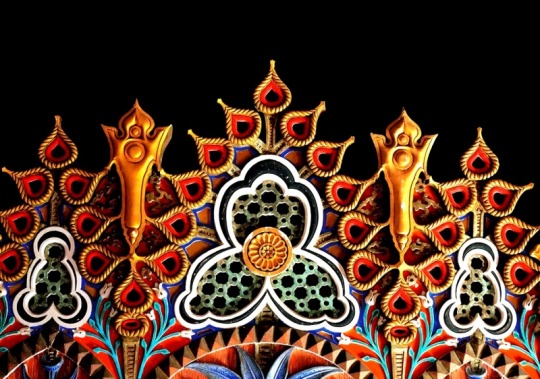

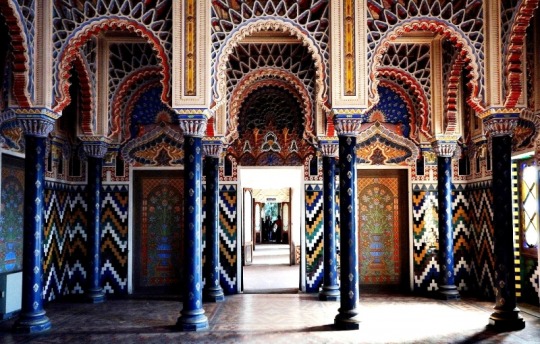

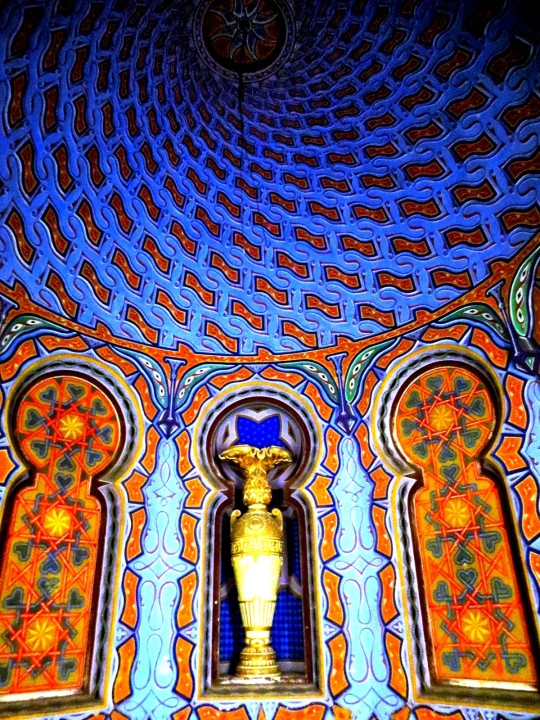



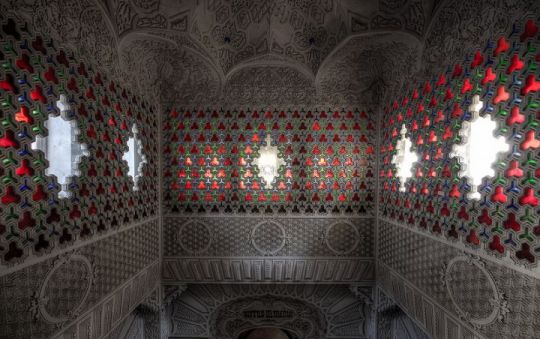
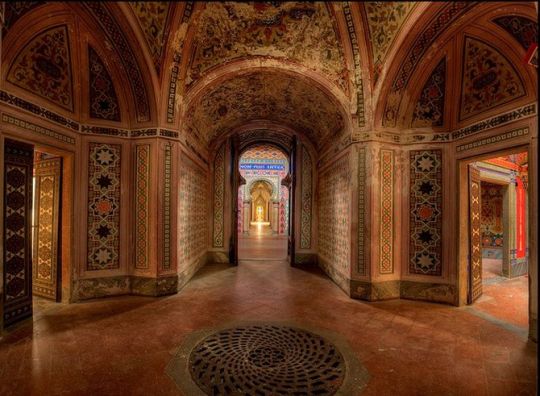


Замок Саммеццано (Castello di Sammezzano), расположенный в регионе Тоскана, на территории коммуны Реджелло, на окраине Флоренции и рядом с городком Леччио (Leccio) (Италия).Замок был построен в 780 году и за долгое своё существование принадлежал многим знатным семьям.
Имение Саммеццано до 1488 года принадлежало флорентийской семье Гуалтьеротти, затем усадьбой завладели Биндо Альтовити и Джованни де Медичи. В 1564 году великий князь Козимо I установил вето на охоту и ловлю рыбы на обширной территории, прилегающей к замку, а заем преподнес в дар имение своему сыну Фердинанду, будущему великому герцогу Тосканы.
В начале XVII века усадьба была куплена королем Хименеcом Арагонским, а затем в 1816 перешла по наследству к семье Панчиатики в 1816. Именно маркиз Фердинандо Панчиатики Хименес Арагонский между 1853 и 1889 затеял реконструкцию усадьбы в необычный и привлекательный замок, выполненный в мавританском стиле, увлеченный восточным искусством, получившим широкое распространение в Западном Средиземноморье между концом одиннадцатого пятнадцатого века.
Если фасад замка Саммеццано напоминает индийский мавзолей Тадж-Махал, то его внутренние украшения навеяны дворцом Альгамбра в Гранаде. Многочисленные и все абсолютно разные залы замка поражают роскошью отделки: среди них выделяются Павлиний зал , Зеркальный зал, зал Лилий, Белый зал и небольшая часовня, поражающие взгляд невероятным сочетанием ярких цветов. Всего замок насчитывает 365 комнат, по одной на один день года.
На ��егодня, как ни прискорбно об этом говорить, роскошный замок Саммеццано продолжает пребывать в состоянии заброшенности. Формально замок находится в фазе реставрации, однако фактически работы в замке не ведутся.О нём заботятся волонтёры, и экскурсии в нём проводятся крайне редко.
Sammezzano Castle (Castello di Sammezzano), located in the Tuscany region, in the territory of the commune of Reggello, on the outskirts of Florence and near the town of Leccio (Italy). The castle was built in 780 and over its long existence belonged to many noble families. The Sammezzano estate belonged to the Florentine Gualtierotti family until 1488, then Bindo Altoviti and Giovanni de' Medici took possession of the estate. In 1564, Grand Duke Cosimo I vetoed hunting and fishing in the vast area surrounding the castle, and a loan gifted the estate to his son Ferdinand, the future Grand Duke of Tuscany.
At the beginning of the 17th century, the estate was purchased by King Jimenez of Aragon, and then in 1816 it was inherited by the Panciatici family in 1816. It was the Marquis Ferdinando Panciatici Jimenez of Aragon, between 1853 and 1889, who began the reconstruction of the estate into an unusual and attractive castle, made in the Moorish style, fascinated by the oriental an art that became widespread in the Western Mediterranean between the end of the eleventh and fifteenth centuries.
If the façade of Sammezzano Castle is reminiscent of the Indian mausoleum of the Taj Mahal, its interior decorations are inspired by the Alhambra Palace in Granada. The numerous and all completely different halls of the castle amaze with the luxury of decoration: among them, the Peacock Hall, the Hall of Mirrors, the Hall of Lilies, the White Hall and a small chapel stand out, striking the eye with an incredible combination of bright colors. In total, the castle has 365 rooms, one for each day of the year.
Today, no matter how sad it is to say, the luxurious Sammezzano Castle continues to be abandoned. Formally, the castle is in the restoration phase, but in fact no work is being carried out in the castle. Volunteers take care of it, and excursions are held extremely rarely.
Источник: http://italia-ru.com/page/zamok-sammetstsano-mavritanskii-oazis-serdtse-renessansnoi-toskany,
//tourpedia.ru/sammezzano/,
//italy4.me/toscana/castello-di-sammezzano.html,,
//zagge.ru/sammeccano-krasivejshij-zamok-italii/,
www.mirkrasiv.ru/articles/zamok-samecano-castello-di-sammezzano-toskana-italija.html/
#Италия#история#Заброшенное#заброшенные места#замок#Саммеццано#маркиз Фердинандо#экскурсии#архитектура#фотография#Italy#history#Tuscany#abandoned#Architecture#medieval#castle#Sammezzano#Marquis Ferdinando#excursions#abandonedplaces#abandonedbuilding#abandoned photography#lost in time#photography
44 notes
·
View notes
Text
Capitán Armando Salazar's Spain:

(circa War of Spanish Succession)
One of the things I didn't know when I first started writing fanfic for Capitán Salazar was that technically, Spain wasn't really a single unified country in his lifetime.
If you had asked them where they were from, the men of La María Silenciosa would have been more likely to tell you they were 'Castilian', or 'Aragonese', or any number of the smaller regions across the country.
To give a brief history, from the 700s-1500s AD, Spain was called Al-Andalus, and was under the control of Muslim states. You can still see a great deal of architecture from this time period especially in the South of Spain, the most famous being Alhambra palace (Granada):

But Christianity started to spread rapidly from the 1400s onwards, and by 1502 all Muslims were ordered to either convert or leave (this royal edict is still criticised today, with many debating if the edict was largely responsible for the eventual decline of Spain's economy and population).
Over the centuries, the cultures of each Spanish region became so significantly different from one another that it is not unlikely to have caused tension aboard Salazar's ship.
Southern regions retained strong Moorish influences due to their geographical proximity to Morocco, but this kept them divided culturally and politically from their Northern neighbours.
Catalonia and Aragon (North East) hated the taxes they'd been forced to pay to the new king Philip V in the early years of the war of Spanish Succession. They fought against their neighbours when the King attempted to send Castilian soldiers through their territory. The King punished those who rebelled by taking their homes and lands away - leaving them with nothing.
All of this would definitely have played heavily into the personal identity of each of the men aboard La María Silenciosa: not all of them would necessarily have shared the same language, manners, or way of looking at themselves and the world around them.
It's interesting to me, therefore, that the colour the men of La María Silenciosa wore was grey.
Not the yellow and red stripes of the Catalonian flag. Not the blue and gold coat of arms of King Philip V. No, the colour is deliberately neutral. As if by donning the grey, every man aboard La María Silenciosa is acknowledging that no matter their differences, under Capitán Salazar's command they are one.
#historical spain#capitán armando salazar#potc 5#pirates of the carribean: dead men tell no tales#potc headcanons#i've always kind of headcanoned that Guillermo Lesaro's family are generational farmers from near the french border#Gui is all too aware of his uneducated 'lower' class roots#miguel magda 100% has royalty in his bloodline#and he knows it#but let's hope for his sake it's not Hapsberg blood#i've been playing with the idea that bracero's grandmother was an italian who first settled in the Aragon region after she married#and I headcanoned that Capitán Salazar's grandfather escaped a plague in Valencia to move to Cádiz as a boy in the 1650s#a move which permanently affected the Salazar family#since Cádiz was the main launching pad of the Spanish Armada
31 notes
·
View notes
Photo
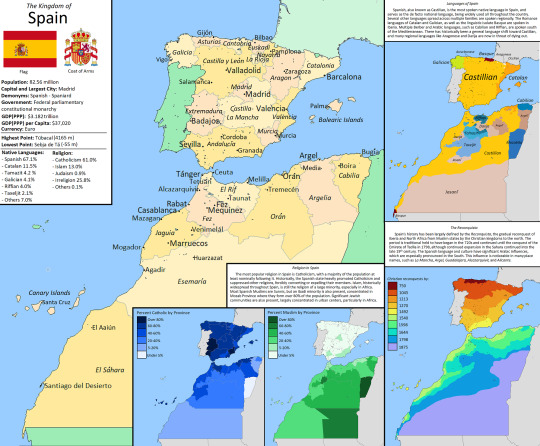
Spain if the Reconquista continued into North Africa.
by u/Aofen
The Reconquista, the centuries long conquest of the Moorish kingdoms of Iberia ended in 1492 with the fall of the Emirate of Granada to Spain. The Spanish and Portuguese did try to extend there rule into North Africa, seizing several cities in North Africa. The Spanish briefly controlled cities like Algiers and Tunis, and held control of Oran for almost 200 years, but ultimately lost all but the cities of Ceuta and Melilla and a few small islands. The discovery of the Americas ultimately diverted Spanish interest to building an overseas empire instead of expanding into Africa.
In this imaginary timeline, Spanish imperialism in the Americas is hampered when the conquistadors of the Aztec and Inca Empires set themselves up as independent kings with the help of Spain's colonial rivals (This was apparently, very briefly, an actual fear of the Spanish). Spanish interest in conquest is instead diverted to North Africa, which by the 21st century is an integral part of Spain, containing about 40% of its population and the majority of its land area.
62 notes
·
View notes
Text
SEPHARDIC BNEI ANUSIM IN BRAZILIAN TELENOVELAS AND MINISSERIES
@themousefromfantasyland @gravedangerahead @tamisdava2 @princesssarisa @professorlehnsherr-almashy @the-blue-fairie @amalthea9 @faintingheroine @budcortfancam
A Converso, Marrano, New Christian, Crypto-Jew: these terms are intermittently applied to the men and women of 15th-17th century Spain and Portugal whose identities lingered somewhere between Jews and Christians. In most cases, multiple labels can be used to describe the same individuals, because the boundaries between their identities were porous. For both contemporary observers and for modern historians, the label used reveals more about the labeler than about the phenomenon described.
Jews first settled in the Iberian Peninsula, (the region now known as Spain and Portugal) before the arrival of the Phoenicians in about 900 BCE. Jewish merchants settled along the coast of Spain during the time of King Solomon when this region was called Tarsus, or Tarshish. Iberia was referred to as Sefarad by its Jewish inhabitants and Hispania by the Romans from which the name “Spain” was later derived. More Jews immigrated after the destruction of the First Temple in Jerusalem. When the Babylonian king Nebuchadnezzar conquered Jerusalem, there were already large well-established Jewish settlements throughout Iberia.
The first recorded persecution of Jews in Spain began about 489 CE when Jews were forbidden to marry non-Jews or to hold public office, and any children already born of inter-marriage were forcibly baptized into the Catholic Church.
From this time forward, the Iberian Jews were periodically subjected to progressively worse persecution until finally from 653 to 672 CE, Jews were beheaded, burned alive, or stoned to death for the crime of relapsing from forced conversion to Catholicism back into Judaism. It was during the period of 489 to 711, under Frankish and Visigothic rule, that Crypto Jews (Secret Jews) first emerged as a large group.
In 711 CE the Moors of northern Africa conquered the region and there resulted approximately three hundred years of what is known as the “Golden Age of Tolerance,” when the Muslim rulers coexisted with Jews and Christians. Non-Muslim people were allowed great freedom as long as they paid a special tax, to which the Jews gladly agreed. Jewish art, music, medicine, education and religious study flourished, and the Jewish population increased greatly and prospered, many Jews becoming fabulously rich and famous.
During the Golden Age, Spain became the world center for Talmudic Studies, with some of the world’s most famous rabbinical academies. Some of the greatest Jewish scholars lived in Moorish Spain during the years of transition just after the end of this period of time. Rabbi Abraham ben Meir Ibn Ezra was born in Tudela, Spain, in 1089. He was a poet, mathematician, grammarian, astronomer, commentator of Torah and philosopher. Rabbi Moshe ben Maimon, known as “The Rambam” or “Maimonides,” was born in Cordoba, Spain, in 1135, and earned his living as a physician. He is most famous for his codification of Jewish law, entitled Mishne Torah, and for his philosophical work Guide for the Perplexed. Rabbi Moshe ben Nachman, known as “The Ramban,” was born in 1194. He, like Maimonides, was a physician and scholar who was the first to incorporate Cabala, or Jewish mysticism, into the Torah teaching, and was a strong proponent of taking possession of the land of Israel. Jews and Crypto Jews flourished in relative peace and plenty, enjoying the Golden Age and the free exchange of ideas, a relatively high level of education for that time in the world, and the benefits from living among Torah and Talmudic scholars. Cities such as Lucena, Granada and Tarragona were populated by Jews magnificently wealthy in culture and material goods.
However, the so-called Golden Age in Spain was also marked by occasional violent upheavals and political turmoil that affected the Jews and Crypto Jews, who were subject to the whims of the frequently changing governments. For example, violence erupted in 1002, when two politically powerful and wealthy Muslims fought to rule Granada; unfortunately the Jews had backed the loser and suffered from Muslim suspicion thereafter. In 1066 a Jewish chief minister of Granada was crucified, followed by the slaughter of more than 1500 Jewish families. The original Moorish dynasty was overpowered by the fanatical Muslim Almoravides in 1086, who were in turn overpowered by the even more fanatical Muslim Almohades from Morocco in 1112. By 1149 the Almohades had overrun the entire peninsula which had become fragmented into about twelve small kingdoms. The lack of centralized control caused constant power struggles among neighboring kingdoms, such that the Almohades were unable to gain a strong hold on the peninsula.
Although the Jews had coexisted relatively peacefully with the Muslims, the Catholics bitterly resented the loss of Christian control of the peninsula since 711 and had perpetuated unrest and uprisings, and by 1212, outright rebellion. The centuries-long “Reconquista,” or reconquest, of the entire region was considered a holy obligation. Unfortunately, to the Christians, the Jews were identified with the death of their Christ and with the Muslim rulers under whom the Jews had enjoyed privilege and power. Also during this period of time, the Black Plague was ravaging Europe, killing as many as one in every four people, but far fewer of the Jewish population. Relatively few Jews died from the Plague perhaps because of better hygiene. Jews washed their hands before eating bread, bathed weekly prior to Shabbat and before holidays, washed their clothing regularly, maintained sanitary households (especially the kitchen and toilet facilities), consumed only fresh and kosher meats from healthy animals, were required to be distant from sewage and other forms of uncleanliness when reading Torah, and buried their dead within twenty four hours. All of these practices in combination with segregated all-Jewish neighborhoods provided some measure of protection from the Plague, albeit not total immunity. The Catholics did not observe such hygienic lifestyles, and seldom washed or bathed. The Catholics hated the Jews for their apparent immunity to the Plague, and widely believed the canard that the Jews were the source of the “Black Death” by poisoning wells.
The Catholics united against the Muslims who were absorbed in fighting one another and slowly took over most of the small kingdoms, one by one. Catholic rule was not kind to the Jews. Widespread pogroms in 1391 resulted in the deaths of fifty thousand Jews, such that, in fear for their lives, tens of thousands converted to Catholicism. These people were called “Conversos” (converts), “New Christians”, and “Maranos” (a derogatory term meaning “pig people.”) In 1412, the Laws of Catalina were promulgated, which excluded Jews from any economic interchange with Christians. From this time until the Edict of Expulsion in 1492, Jews were strictly confined to ghettos and had to wear identification badges prominent on the outside of their clothing. Hard-pressed to survive, many Jews, perhaps as many as 600,000, converted to Christianity by the end of the fifteenth century. Many of the New Christians were in reality Crypto Jews, outwardly Christians, but tenaciously and secretly practicing Judaism.
The Spanish Edict of Expulsion of 1492 stated that all Jews must leave the country. Those who stayed faced the Inquisition. A small number fled to Italy, Amsterdam, and the Americas, but most went to neighboring Portugal. When the Inquisition came to Portugal in 1496, the Jews were forced to leave, convert, or die. Of those Conversos who opted not to emigrate, many, if not most, were murdered by the “Holy” Inquisition. By 1500, estimates of as few as 40,000 and of more than 200,000 Jews were forced to leave the Iberian Peninsula. Exact numbers are not available because many of the Crypto Jewish family names had been changed after the pogroms of the 1300s in anticipation of future persecution.
The Spanish and Portuguese Inquisition continued for three hundred and fifty years. Accurate recorded accounts of the names, numbers, dates and punishments were kept by the officers of the Inquisition, such that today anyone who cares to recount the horrors may read of them. Of those Jews and Crypto Jews who chose to not leave, or could not afford to leave the Iberian Peninsula, many later bought passage or a commission on a sailing ship bound for safer destinations, preferably as far as possible from the nearest Office of the Inquisition.
Some purchased the proper documentation for “temporary” (which frequently became permanent) business trips to Italy or Germany, whereas poorer people fled to the north through the mountains and into France. Entire communities of “Portuguese Christians” were documented in southern France, while others continued northward to Amsterdam, England, Scandinavia, and eastward to the German provinces, Austria, Hungary and Poland. In most of these European destinations, these “Portuguese Christians” eventually revealed their true identity as Jews, and then subsequently blended into the established Jewish populations; thus, we do not find long histories of Crypto Judaism throughout Europe.
Many Jews and Crypto Jews immigrated to the New World, now known as the Americas, or the Western Hemisphere. Their choices were limited to the colonies of Spain and Portugal, so that when the Inquisition came to Peru in 1570, to Mexico in 1571, and to Cartagena in 1610, these same people were forced again to choose to convert or to die. The Inquisition spread throughout what is now the southern United States of America, Mexico, Central and South America, the islands of the Caribbean, and Cuba. No Jew or "Converso" was safe from suspicion, accusation and persecution, thus the numbers of Crypto Jews swelled to encompass almost all people of Jewish descent. The experience of the Crypto Jews in the Western Hemisphere was a litany of suffering, continual fear, social, political, professional, and religious suppression and murder. As late as the 1850s the Inquisition was finally officially ended in Mexico, and elsewhere a little sooner; however, overt discrimination and random incidents of lynching and murder continued until well into the 1950s in what we now call "Latin America".
The final result of approximately one thousand years of persecution and murder of the Spanish and Portuguese Jews (minus the three hundred years of the "Golden Age") caused many families who immigrated to the New World to become Crypto Jewish, while living their public lives as Catholics. In the Americas, some of the Crypto Jews reverted to being openly Jewish, only to find a few years later that the Inquisition had followed them to their new homes, and they were forced to go back into hiding again. All of these people, the "Conversos" or "New Christians", were forced to submit to Catholicism, thus in Hebrew they are referred to as the "Anusim" or "those who were forced."
It has been approximately fifteen-hundred years since the emergence of Crypto Jews in the Iberian Peninsula, and five-hundred years since Crypto Judaism moved to the Americas. Today we find a large Crypto Jewish presence throughout the Western Hemisphere. No one knows for sure how many there really are, however in Brazil alone an estimated 10 to 25% of the total population are Crypto Jews, which translates to 15 to 40 million people.
Some period setting audiovisual productions in Brazil took interest in the history of the Anusim during the colonial period, and two teleivision productions included Anusim characters as main figures in their narratives.
Xica da Silva (1996-97)
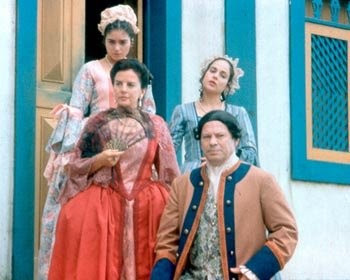
This telenovela produded by Rede Manchete, set in 18th century Brazil, told the story of Xica da Silva, a black woman who was born in Brazil and was enslaved, until a white and rich portuguese man named João Fernandes fell in love with her, made her his lover and gave her freedom, making her one of the most rich and powerfull people of Arraial of Tijuco (now the city od Diamantina, Minas Gerais).
Among the side characters who were part of Xica da Silva and João Fernandes's story, were the Pereira family, who were jewish people that came from Portugal to Brazil hoping to escape the Inquisition, and were atracted to the Arraial of Tijuco because of the diamonds that were found there.
Teodoro (António Marques) was the patriarch, Guiomar (Lídia Franco) was his wife (who threw tantrums when she saw a slave naked) and Joaquina (Rosa Castro André) and Graça (Anabela Teixeira) were his daughters.
Both sisters were in love with the gentile travelling merchant Felix (Jayme Periard) who, despite loving Graça, is forced by tradition to marry Joaquina (in a plot inspired by the hebrew tale of how Laban tricked Jacob to marry Leah, despite having promised the hand of Rachel).
Like most characters in the narrative, being to the historical period being portrayed on screen, the Pereiras were slave owners, and Teodoro sexually abuses Fatima (Ilea Ferraz), one of the black woman who is enslaved in his house, and this results in the conception of an illegitimate child.
Later, when Fatima falls in love with another enslaved black man named Jerônimo (Alexandre Moreno) the two join forces to find a plan to take revenge on the Pereira family and get their freedom.
This plan takes form during the visit of a representative of the Inquisition to Arraial of Tijuco: The two reveal to the Inquisitor that the Pereiras had a 7-pointed candlestick (which the representative recognizes as a description of the jewish menorah), hidden in a chest.
At the end of the telenovela, the Pereiras are put under arrest by orders of the Inquisitor, who will take them to trial in Portugal. Felix comes to rescue one of the women, and the baby he had with Joaquina. Joaquina is to ill to run with him trough the woods, so she sends her sister Graça (who she always knew was Felix's true love) to go with him and her child, and Guiomar asks her son-in-law to take away the family's menorah, so her grandson will always remember his jewish origin.
Xica da Silva was a story of black and gray morality: most characters were capable of being simpathetic, and also held prejudiced beliefs and take part in cruel acts, because those were normalized by the political system, rather than a question of individual morals.
This ambiguity was also shown in the Pereiras, who were both victims of opression for being targets of antisemitism, and perpetrators of opression for participating in the widespread enslavement of black people, when owning slaves was considered prestigious and respectable.
A Muralha (2000)


In the year of 2000, during the 500th anniversary of the arrival of the portuguese squad to brazilian shores (which started the proccess of colonization), Rede Globo produced a minisseries set in the early 17th century called A Muralha (literal translation The Wall, titled The Conquest for international markets) , based on a novel written by Dinah Silveira de Queiroz, that told about the everyday life of the people who lived trough the proccess of colonization, economic exploitation and territorial expansion led by the portuguese and their descendants born here, during the period known as "Bandeiras".
The point of view which we followed those stories was primarily of the women living through that period, and one of these women was the portuguese jewish Dona Ana Cardoso (Letícia Sabatella), who arrives in Brazil to get in an arranged marriage to Dom Jerônimo Taveira (Tarcísio Meira).
Dona Ana owes a moral debt to Dom Jerônimo: he is the brother of the inquisitor who saved her father from death in Portugal. Falsely converted to Catholicism and originally resigned to her fate, Dona Ana's resignation is put into question when she is courted by the rich merchant Dom Guilherme Shetz, a libertine man who lives in harmony with nature and the Indigenous people.
The man who marries Dona Ana, Dom Jerônimo, knows how to be a scoundrel and a pretender before the authorities, but he does not respect them, and he is foolish towards the priests, but in reality he is a cruel man, who imprisons Ana on his property to satisfy his most perverse desires.
After denouncing several residents to the Inquisition for alleged heresy, Dom Jerônimo orders the arrest of those who defy his authority, including Ana and Guilherme. To everyone's astonishment, everyone is condemned to the stake. But Guilherme stabs the villain, who ends up dead in one of the fires he lit himself.
Ana and Guilherme run to live in a cabin built in the woods, and end the story living happy, expecting their first child.
Another jewish character present in the narrative was the jolly Master Davidão (Pedro Paulo Rangel): whereas Ana is more resignated, Master Davidão, while also being carefull in hiding his jewish faith, is more confident and optimistic, not letting himself be afrayed of those in power.
His joifull personality and kidness eventually win the love of Antônia Brites (Claudia Ohana), a former prostitute who came to Brazil in search of a happy marriage, and at the end, having also survived the rage of Dom Jerônimo, the two get married.



While Davidão and Ana refused to convert to Christianity, Simão (Paulo José) was an Anusin who fully embraced it years prior, having become a priest and acting as a leader of the Jesuit Order that comes to the colonies to convert the natives.
His position was in a complex middle ground: While he really believed in Christianity as the only path to salvation, he also called out those who, like Dom Jerônimo and the Inquisition, wanted to impose it trough violence, and frequented acted as a healer and confident of Dona Ana in the moments where she was enduring abuse.
Whereas Xica da Silva was more dark and dealt in black-and-gray morality, A Muralha had more heroic characters, who represented the views on the search for social progress among those who viewed religious and racial hierarchy as natural.
#judaism#jewish representation#the history side of tumblr#brazil#telenovelas#being a child in latin america
13 notes
·
View notes
Text
TW: blood, violence

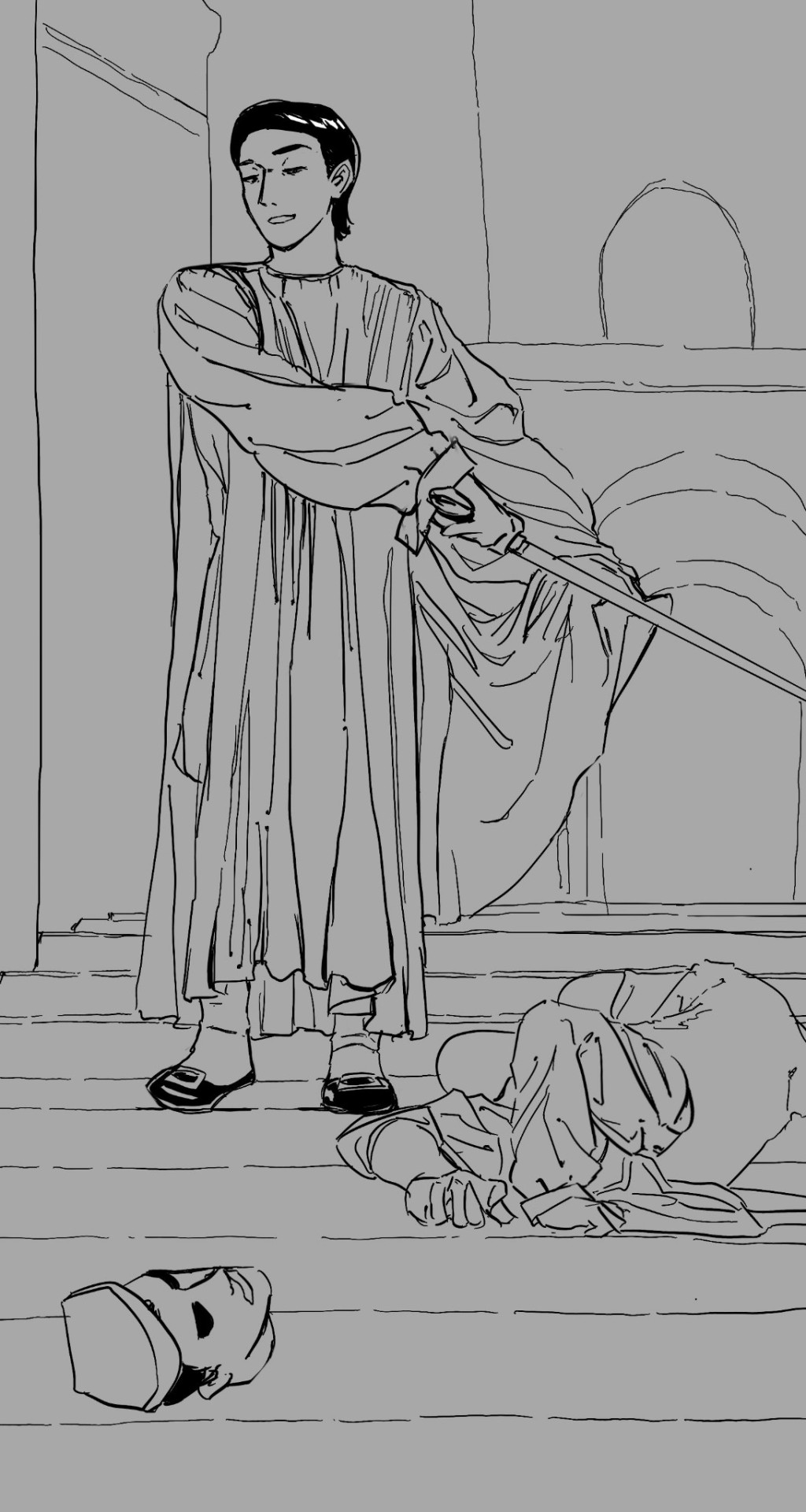
Niccolò as one of my favourite paintings of all time, "Summary Execution under the Moorish Kings of Granada" by Henri Regnault
Also, this was originally intended to be a fabric study, but then I thought, 'Why do a regular study when I could be drawing SINF fanart?' And here we are now
28 notes
·
View notes
Text
According to researchers: The territory of Portugal has been continuously populated since prehistoric times: occupied by Celts, such as the Galaic and Lusitanians, was integrated into the Roman Republic and later colonized by Germanic peoples, such as the Suevi and the Visigoths. In the eighth century, the lands were conquered by the Moors. During the Christian Reconquest was formed the County Portucalense.
Most Serene Highness Dom Filipe, Count of Rio Grande.
Key people and Events of Moorish Iberia discussed in the literature.
It seems a lot of input was generated from the painting of Multiethnic Portugal (Chafariz d'El-Rey ). The history is very complex and worthy of gaining some knowledge about the history of the people. Just for clarification, the intent was for folks to examine the painting and do some research utilizing sources in the bibliography close to the time being written about from several sources. There is a lot going on in the painting by this unknown artist of the 16th century. Please ignore the bots, and people who prefer to be wrapped in racism and ignorance.
The Visigoths starting to be discussed in the 6th century- vague history, recent converts to Catholicism and anti Jewish sentiment.
Other peopling of Portugal
Leadership and power changes at different periods even among the Arabs and the Moors. The geographical locations of Portugal were under different influences and control between the 6th century and the 16th century.
Key Characters
Christendom -Christians
Jews (multi- ethnic)
Muslims (multiethnic) multi sects
Early Almoravids
Umayyads
Later various Berber and Arab principalities
Later Almoravids
Almohads
Moors (said to be Berbers, whatever that means)
Morrish Jews
Conversos - Jewish converts to Christianity, also called cristãos-novos. Means new-Christians.
Moriscos - Islamic converts to Christianitian
Nasrid dynasty The last of the Moorish ruling power in Spain when Granada fell under the leadership of King Boabdil.
Ever expanding Ottoman Empire
Scholars estimate more than thirty thousand expelled Jews settled in the Ottoman Empire between 1492 and 1510, with a large majority going to North Africa. However, they were dispersed throughout the lands near and far.
Marcelino de Unceta y López~Sigh of the Moor

2 notes
·
View notes
Text

Here are some facts about the Moors in Europe: They ruled Spain and Portugal 754 years before the fall of the Mali Empire.
1. The Moors brought a wide variety of new fruits and vegetables to Europe.
The Moors brought many new fruits and vegetables to Spain and Europe that were considered exotic novelties at the time. These products included pomegranates, peaches, lemons, oranges, saffron, cotton, rice, silk, sugar cane, and a variety of other fruits and vegetables. Even though they are commonplace today, the Spanish at the time considered these objects to be almost alien. Several centuries later, they are still important components of Spanish food and production.
2. The Moors Developed Far More Rapidly Than Medieval Europe
The Arabs had an advanced civilization known for its architecture, science, mathematics, and exploration when they conquered the Iberian Peninsula. When the Moors arrived in Spain, they brought with them architectural innovations that astounded European stonemasons. The Alhambra, a fortress and palace complex in Granada, Spain, is one of the most stunning examples of Moorish architecture. Its construction started in 1238, and its grandeur and beauty far outstripped those of any comparable palace. It is still one of the palaces of the Islamic world that has been preserved the best today.
3. Chess Became Popular Across Europe Because of the Moors
Chess has been played for more than 1,500 years, but the Moors brought the game in its present form to Europe. The Moors brought chess to Spain after it had spread from India to the Arabic world. It spread through Europe's courts and society very quickly after it gained popularity. Chess was a well-liked game of strategy and endurance in medieval Spain. Chess was first mentioned in writing in Spain in the Catalan Testament in 1010 AD.
4. The Moors Took Their Hygiene Very Seriously.
A Moor, according to a catchphrase, "would rather go without bread than without soap." The Moors were known for their love of cleanliness. Due to their customs and the demands of their religion, the Moors valued cleanliness and often bathed; in the Moorish town of Cordoba, there were about 900 public baths. This made it possible to maintain proper hygiene at a time when plumbing and running water were still uncommon. Some sources also assert that the Moors introduced some kind of soap to Europe, ushering in a new era of hygiene.
5. The Moors Placed a High Value on Education
The Moors placed a high value on education and made sure that everyone in their realm had access to it. This was in stark contrast to medieval Europe, where education was only available to the richest nobles and clergy and where 90% of the populace was still illiterate. In fact, there have even been instances of European Kings who are illiterate. The Moors founded 17 prestigious universities in Spain, including ones in Cordoba, Malaga, Granada, Seville, Toledo, and Almeria.
6. Many Moorish Words Are Still Used Today in Spanish and English
The Moors introduced new ideas and words to Europe after they arrived, and these quickly assimilated into the common language. Up to 4,000 words in the Spanish language have Arabic roots, including algebra, checkmate, and influenza. Cipher, alcohol, chemistry, typhoon, orange, alkaline, cable, and nadir are additional examples.
7. The Moors Were Very Resourceful
The old Roman irrigation systems that the Moors discovered in Iberia had great potential, so they quickly adopted, improved, and revived them. This increased agricultural productivity and boosted the economy. Additionally, they were able to grow new crops they had brought, including figs, dates, apricots, lemons, and oranges. Thanks to the Moors' creative irrigation methods, Spain quickly rose to become one of Europe's top producers of crops.
8. The Moors brought significant Changes to Spanish Cuisine
For Europeans, spices were an uncommon commodity, and their cuisine was frequently regarded as bland. By bringing over hundreds of unusual spices, fresh recipes, and cutting-edge cooking techniques, the Moors altered that. We still eat a variety of wonderful dishes as a result of this culinary revolution. The spice markets of the Moors were renowned for their variety and provided options for chefs of all types. These medieval markets must have had the most amazing sights and smells.
#moors#mali#arabs#history#spain#portugal#europe#cuisine#food#spaintravel#lonely planet#architecture#good vibes#vibes#lifestyle#style#mood#aes#aesthetic#aesthetics
7 notes
·
View notes
Text
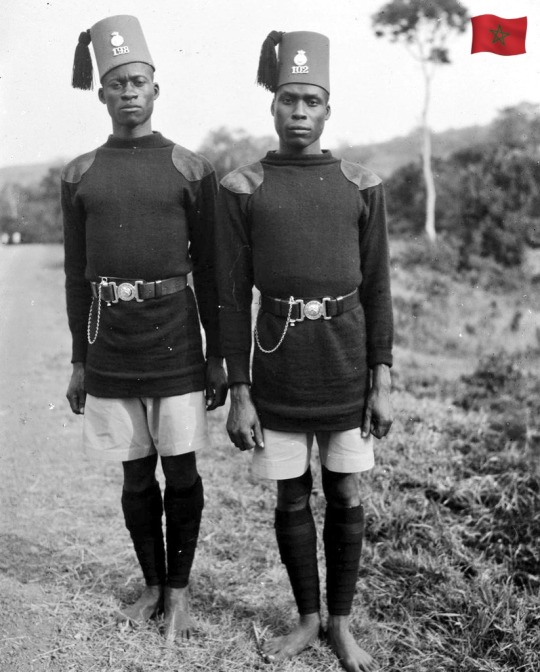
The Moors Ruled Spain and Portugal 754 Years Before The Collapse of The Mali Empire
Here are some facts about the Moors in Europe:
1. The Moors Introduced Numerous New Fruits and Vegetables to Europe
The Moors introduced a variety of fruits and vegetables that were previously unknown in both Spain and Europe, and thus deemed exotic novelties. These items included peaches, lemons, oranges, saffron, cotton, rice, silk, sugar cane, apricots, figs, dates, pomegranates and many others. Although commonplace today, during the Middle Ages these items were almost alien to the Spanish. Today, centuries later, they have become staples of Spanish production and diet.
2. The Moors Were Several Steps Ahead of Medieval Europe
At the time of their conquest of the Iberian Peninsula , the advanced civilization of the Arabs was renowned for its architecture, science, mathematics and exploration. Upon their arrival in Spain, the Moors introduced architectural techniques that amazed European stonemasons. One of the most impressive examples of Moorish architecture is the Alhambra, a palace complex and fortress located in Granada, Spain. Construction began in 1238, and it surpassed any similar palace in grandeur and beauty. Today, it remains one of the best-preserved palaces of the Islamic world.
3. Chess Spread Throughout Europe Thanks to the Moors
Even though chess is over 1,500 years old, it was first introduced to Europe in its current form by the Moors. Chess spread from India to the Arabic world and was introduced to Spain by the Moors. It quickly became popular and swept across Europe's courts and society. In medieval Spain, chess was a popular game of strategy and patience. The first written mention of chess in Spain dates back to 1010 AD, in the Catalonian Testament.
4. The Moors Were Very Strict About Their Hygiene
The Moors were known for their love of cleanliness, with a popular saying claiming that a Moor "would rather go without bread than without soap.” Due to their traditions and the rigors of their religion, the Moors were fond of looking spic and span, and encouraged frequent bathing; In the Moorish town of Cordoba, there were around 900 public baths . This allowed for proper hygiene during a time when plumbing and running water were not yet widely available. Some sources also claim that the Moors brought some form of soap to Europe, introducing a new era of cleanliness.
5. Education Was Very Important to the Moors
Education was of utmost importance to the Moors, who ensured that it was universally available to all within their realm. This stood in stark contrast to medieval Europe, where 90% of the population remained illiterate, and education was reserved for only the wealthiest nobles and clergy. In fact, there were even some European Kings who could not read or write. The Moors established 17 great universities in Spain, located in cities such as Cordoba, Malaga, Granada, Seville, Toledo and Almeria, among others.
6. Numerous Moorish Words Found Their Way into Modern Spanish and English
After their arrival in Europe, the Moors brought with them new concepts and words that quickly became a standard part of everyday language. Spanish has up to 4,000 words of Arabic origin, including algebra, checkmate, and influenza. Other examples are cipher, alcohol, chemistry, typhoon, orange, alkaline, cable and nadir.
7. The Moors Were Very Industrious
Upon their arrival in Iberia, the Moors saw the potential in the old Roman irrigation systems they found and quickly adopted, enhanced and revived them. This led to a surge in agricultural productivity and a boost in the economy. They were also able to cultivate new crops they brought with them such as lemons, oranges, figs, dates, and apricots. Soon, Spain became one of the largest producers of crops in Europe, all thanks to the Moors' innovative irrigation techniques.
8. The Moors Greatly Transformed Spanish Cuisine
Spices were a rare commodity for Europeans, and their food was often considered bland. The Moors changed that by bringing over hundreds of unique spices, new recipes and innovative methods of preparing food. This culinary revolution gave rise to many wondrous dishes that we still enjoy today. The Moorish spice markets were famous for their variety, offering choice for cooks of all styles. The colors and smells of these medieval markets must have been truly incredible.
#ramadanmubarak#themoorish#Asiatics#ceasethefolly#Moors TheUnitingofAsia NobleDrewAli#DrewAli Moroccans#la ilaha illa allah
7 notes
·
View notes
Text
The Reconquista & Moorish Resistance in Spain: Rebellion of the Alpujarras (1499-1501)
1492 was one of the most consequential years for the nationhood of what is now Spain. Not only was it the year Christopher Columbus & his crew reached the Americas in the name of the Spanish monarchs. An event that ignited the subsequent centuries long European exploration & conquest of the North American & South American continents. 1492 was also the year that most historians deemed the official end of the so-called Reconquista.
The Reconquista (reconquest) was also commonly viewed as a centuries long project of entailing conflict between the Christian kingdoms of the Iberian Peninsula (modern Spain & Portugal) aimed at “retaking” the land from the Islamic invaders who hailed from North Africa & the Middle East and ruled over large swaths of land collectively known as Al-Andalus. The grouping of Muslims in Iberia came to collectively be referred to as the Moors. As we’ll elaborate in this post, the Reconquista fitting into a binary Christian European versus foreign Muslim narrative is probably too narrow to accurately the describe the period in question. Nor as we’ll discuss later does the year 1492 automatically signal an end to the Moorish community such as it was within Iberia. As with much of history there is much more nuance to these topics. To get a more accurate picture of history requires accepting that nuance however inconvenient to our preconceived notions did in fact & does in fact exist in virtually every historical event recorded across the spans of time & space.
Let’s then define the rough time period we mean, when we discuss the Reconquista. Historians commonly refer to the Reconquista to be roughly from the year 718/722 AD/CE starting with the Battle of Covadonga lasting until the Fall of Granada in 1492 AD/CE. These are generally the bookends of Reconquista which are more or less accepted by historians today. For further context, let’s remind ourselves of what brought about the Reconquista & then discuss whether that it was a simple case of Christian vs. Muslim.
The Islamic Conquest of the Iberian Peninsula is generally believed to have begun in the year 711 AD/CE when a force of Muslims made up of mostly Berber or Amazigh (native peoples from North Africa) with some Arabs crossed the Straits of Gibraltar from modern Morocco & invaded modern-day Spain. This force was led by one Tariq ibn Ziyad (670 CE-720 CE). Tariq was a Berber from North Africa whose people had only within the last few decades come to embrace Islam & not completely. The early Islamic conquests spread rapidly following the death of the Prophet Muhammad in 632 CE. Muhammad had largely succeeded in uniting the Arabian Peninsula under Islamic rule by his death. From there under the first Islamic empire of sorts, the Rashidun Caliphate (632 CE-631 CE) saw conquests of both some of the Middle East and some of North Africa, namely Egypt from the Eastern Roman Empire (Byzantine Empire) & Iranian Plateau from the Persian Sassanian Empire. Following the First Fitna (civil war), the Rashidun Caliphate was succeeded following the death of Muhammad’s cousin & son-in-law Ali ibn Abi Talib, the 4th and final caliph of the Rashidun (rightly guided). They were succeeded by the Umayyad Caliphate (661 CE-750 CE), the 2nd major Islamic caliphate. The Umayyads were an Arab dynasty & distant relatives of Muhammad taking power after the First Fitna from their power base in Syria. They changed the trajectory of Islamic history in a number of ways. In a leadership level, they became the first hereditary Islamic dynasty, making the caliph less of a religious & political leader & primarily a political leader akin to a king or emperor in practice though nominally had the religious leadership attached to the title but this would decrease in practice overtime. The succession of caliphs were now passed essentially from father to son whereas the Rashidun caliphs were elected by a council called a shura who tried to assess the merits of the candidates proposed. Leadership was intended to be based on those whose character & ability would exemplify Islamic teaching & virtue as they believed the Prophet Muhammad had exhibited in his leadership.
The Umayyads greatly expanded the Islamic conquest to the whole of North Africa by the late 7th century & all the way into parts of Central Asia & the Indus Valley in modern Pakistan & India. They also extended northward into Byzantine held Anatolia (modern Turkey) and the southern Caucasus (Armenia). They further extended their reach into Europe with raids in the Mediterranean including the Iberian Peninsula by the late 7th & early 8th centuries CE. While Islamic teachings held that all Muslims were equal in terms of value regardless of ethnic or geographic background & the Umayyads did indeed rule over a vast multiethnic & multireligious empire, in practice they maintained a preference for Arab Muslims among the bureaucracy & aristocracy to rule over the empire. A hierarchy formed with the Arabs at top, non-Arab Muslims such as Persians, Egyptians, Greeks, Armenians & Berbers who recently converted as generally beneath the Arabs & below them Christians & Jews who did not convert to Islam along with other non-Abrahamic religions at the bottom of the hierarchy. Christians & Jews however were allowed to practice their religion without interference so long as the jiyza poll tax was paid to fund the caliphate’s operations in part.
It was under the Umayyad Governor of Ifriqiya “Africa” (modern Tunisia, Algeria & Libya) Musa ibn Nusayr, an Arab from Syria that Tariq ibn Ziyad was ordered to cross the Straits of Gibraltar & invade Iberia. At the time Iberia was under the control of the Kingdom of the Visigoths. The Visigoths were a Germanic people from Northern & Eastern Europe that moved nomadically into the Roman Empire during the late classical period into the early medieval period. They were among the so-called barbarian hordes that overran the western Roman Empire & had famously sacked Rome itself in 410 AD/CE. This contributed to the eventual downfall of the Western half of the Roman Empire. The Visigoths in time however along with other Germanic peoples like the Ostrogoths, Vandals & Franks began to adopt elements of Roman culture from the areas over which they now ruled. Picking up Latin as an official language & even adopting Christianity. The Visigoths had helped the Romans at one point fend off Attila the Hun and his nomadic empire in the plains of France. The Visigoths had settled in southern France before crossing into Spain where they overtook the Hispano-Roman population. The Hispano-Romans were a mixture of native Iberians, Celts, Carthaginian & Greco-Roman settlers among others in Iberia who more or less coalesced into a common people that spoke Latin & practiced a precursor to Catholic Christianity. Iberia likewise contained the native Basque peoples who maintained their own unique language & culture to this day, largely protected by their residence in the mountainous northern reaches of Iberia & southern France. The Visigoths ruled over them as powerful warrior minority who overtime increasingly assimilated into Hispano-Roman majority but still maintained serious differences. The brand of Christianity practiced by the Visigoths was known as Arianism & differed from the Christianity of Hispano-Romans. They also dealt with somewhat unsettled monarchical rules. Civil war occurred among the Visigoths for kingship which was not necessarily hereditary.
It is said that the rule of a Visigoth King by the name of Roderic who reigned from 710-711 was the impetus for the Muslim invasion. There is much debate about whether Roderic’s reign itself was the cause for the invasion as there is a fabled tale that he seduced or raped the daughter of one of his nobles who turned to the Muslims of the Umayyad Caliphate to act as a mercenary force to avenge & depose Roderic in exchange for conquest of the peninsula. This tale was sometimes accepted as fact but may actually be a tale or contain some elements of truth, the historical record to this day is limited on this. However, what seems to be known is that Roderic’s reign was not fully accepted by other Visigoth nobles within the kingdom & was disputed at best & perhaps ignited civil war or at least created a division that may have led to conspiracy between Visigoth nobles & Umayyads. Whatever the reality, the opposition to Roderic did create an opportune moment for an army of Berber and Arab Muslims (Moors) to land at the Rock of Gibraltar & begin their in-land push to begin conquering the Iberian Peninsula also known as Hispania. Gibraltar in fact takes its name from Tariq ibn Ziyad’s first name. In Arabic the rock which is the symbol of the modern British possession Gibraltar was known as Jabel-al-Tariq (Rock of Tariq), in antiquity it was known as one of the Pillars of Hercules. Roderic raised an army to oppose the Muslims and was defeated it is said due to betrayal of his own forces at Battle of Guadalete. This is turn opened a rapid conquest of virtually all of the peninsula within a decade. The Muslims received more Berber & Arab reinforcements and were more or less accepted by some of the Visigoths & Hispano-Roman population. The Umayyads had added the regions known in Arabic as Al-Andalus or land of the Vandals (Germanic peoples who reigned in Iberia earlier) as their western most province.
For virtually a decade their conquest went unimpeded due to the divisions among the Visigoths & the Hispano-Romans. However, the northern mountains of Hispania did protect some retreating Visigoth & Hispano-Roman Christians as it did their Basque neighbors. Creating a relative safe haven for them in the form of a new kingdom, the Kingdom of Asturias. Additionally, the Muslims had to now consolidate their hold over southern & central Iberia as well as the coasts. Further strains to the Islamic cause came in the form of division between Arab & Berber. The Arabs typically were new to North Africa much less Europe & due to Umayyad preferences were often given leadership positions & the greater spoils of war over the more numerous Berbers who acted as the rank & file soldier typically, leading to lingering resentment. These divisions would persist off and on throughout the history of Al-Andalus, notably in the Great Berber Revolt of 740-43. The Battle of Covadonga fought in either 718 or 722 CE saw the Asturians defeat the Umayyads for the first discernable time & allowed a check on their ambition to completely rule the peninsula. Other setbacks to Muslim conquests came in their invasions of France where in 721 they were defeated in the Siege of Toulouse & in 732 the Franks decisively defeated the Muslims at the Battle of Tours.
In 750 CE, the Umayyads were overthrown by a new Arab dynasty with closer blood ties to the Prophet Muhammad, the Abbasid dynasty. The Abbasid Caliphate (750-1258 & 1261-1517) were descended from the Prophet’s uncle & while they maintained the Umayyad preference for hereditary succession to the caliphate, they reversed the Umayyad preference for an Arab only bureaucracy, largely using Persians to fill government roles & allowing other non-Arabs likewise to fulfill leadership roles. The Abbasids would likewise preside over an age of cultural flowering within the Islamic world, the so-called Islamic Golden Age with the establishment of Baghdad in Iraq as their capital. They’d rule over the largest Islamic empire in history but one not entirely united as they would soon lose Al-Andalus.
The Abbasids would try to kill every remaining Umayyad but one named Abd Al-Rahman Al-Dahkil (the Entrant) managed to escape Syria while witnessing his brother’s execution. Abd Al-Rahman’s father was Arab but his mother was Berber & he sought refuge among his mother’s relatives in North Africa which had become relatively autonomous under the Umayyads due to the rule of another Arab noble dynasty known as the Fihrids. They accepted Abd Al-Rahman’s exile within their borders as they themselves were not eager to accept Abbasid rule & did so nominally. The Fihrids had spearheaded the Arab conquest of North Africa & now ruled as governors of Al-Andalus well into the 8th century but divisions amongst the Yemeni & Syrian Arab factions and Berber factions created an opportune moment for Abd Al-Rahman to make his way into Iberia. There with an army of Syrian Arabs & Berbers he defeated the Fihrid governor of Al-Andalus. In turn he now created an independent Emirate (Principality), the Emirate of Cordoba (756 CE-929CE) which later evolved into the independent and rival Caliphate of Cordoba (929 CE-1031 CE). The Umayyad direct rule over Cordoba likewise saw a cultural flowering which rivalled that of the Abbasids in Baghdad. With geography & other more pressing issues closer at home, the Abbasids de-facto accepted the Umayyad reign over Al-Andalus. This peaked under the reign of Abd Al-Rahman III who reigned as Emir from 912-929 before declaring himself as Caliph of Cordoba and ruling as caliph from 929 to 961. Cordoba became a major center of learning in Western Europe & both as an emirate & caliphate saw much knowledge transfer between Muslim, Christian & Jews. These people could live side by side but by the 10th & 11th centuries CE, the majority population of the Iberian Peninsula was in fact majority Muslim. This populace became collectively known as the Moors to the Chrisitan European world.
What constituted the term Moor? It is derived from the term Mauri originally derived from the Greek term for the Berber tribes of northern Morocco & Algeria, that term was Maurusii or Mauri as it was adopted in Latin later by the Romans after their conquest of North Africa. It also applied to the Latin name for the province of Mauretania. Originally it applied to the Berber peoples of this region, but this preceded the Islamic era by centuries & had no religious connotations. By the time of Al-Andalus, Mauri remained the Latin term for the Berbers but the Muslims were never strictly only Berbers but a combination of Berber & Arabs. The term Moor in English is in turn derived from the Latin daughter Romance languages of Spanish, Italian & French which used the term moro & maure. By the time of Al-Andalus as the Caliphate of Cordoba, Moor was applied to all Muslims within the Iberian Peninsula. This applied equally to Berbers, Arabs & European converts to Islam, the Hispano-Romans & Visigoths also to some degree converted to Islam, as did slaves imported from Eastern Europe via the Arab slave trade. These latter two groups (Hispano-Romans & the Slavic slaves) helped constitute the majority of Iberia’s previously Christian population & it was through this conversion that Islam became the predominant religion of Iberia during much of the Middle Ages. They were known as muwallad.
Moors never truly constituted a specific ethnicity in Spain & Portugal. It was perhaps better described as a cultural or religious designation rather than an ethnic or racial one. Moors came from various ethnic backgrounds spanning 3 continents (Europe, West Asia & North Africa) and could range in skin color from dark to light & fair skinned as it was not a racial designation. Furthermore, the racial divides between Berber & Arabs during the earlier Al-Andalus period began to dissipate gradually over the centuries due to intermarriage between the two communities & this also included muwallad (Hispano-Roman) marriage with Berber & Arab communities as well. In time leading to a community that became better known as Andalusian (taken from Al-Andalus) or to the Christians as Moors.
As the Islamic power changed overtime from emirate to caliphate likewise new Christian kingdoms arose from the north of Iberia. Asturias gave way to the Kingdom of Leon & the Basques formed the Kingdom of Pamplona. In time the kingdoms of Castile & Aragon formed & Pamplona turned into the kingdom of Navarre. As the Reconquista progressed the political interplay between Christian & Muslim powers became complex & despite the common narrative of a strict Christian vs. Muslim conflict much like the Crusades of the Middle East from the late 11th century onward, a more nuanced reality existed. The caliphs of Cordoba were in fact mostly European being only patrilineal descendants of the Arab Umayyads. Their mothers were made up of generations of either European slaves taken in raids or in some cases the Basque & Hispano-Roman royalty of the northern kingdoms who made treaties with the Umayyads & sometimes sent their daughters or sisters to become wives of the emirs & caliphs so as to ensure peace between their respective kingdom. Abd Al-Rahman III, Caliph of Cordoba was the grandson of a princess from Pamplona & great-grandson of the Basque king of Pamplona. He was said to have had fair skin & light eyes & hair/beard which he dyed black to make it appear more “Arab” despite that three-quarters of his grandparents were completely European, the remaining quarter was partially Arab intermixed with European captives in the emir’s harem. Subsequently his cousins constituted the fellow monarchs of northern Iberia he had to contend with both through war & diplomacy.
Throughout the Reconquista era, interaction between Christian & Muslim occurred at all levels in Iberia. Trade, commerce, art, education & cultural exchange was not uncommon in addition to the familial ties of politicians & the ever-shifting alliances. Christian powers were in competition with each other & Al-Andalus, matters complicated further following the collapse of the Caliphate of Cordoba which saw the break apart into numerous Muslim petty kingdoms called taifas. Some ruled by Arab, Berber or muwallad dynasties. Some paired with Christian powers against rival Muslim powers & likewise Christian powers teamed with Muslim powers against fellow Christian powers but the fractured nature of the taifas gave opportunity for Christian kingdoms like Castile & Aragon to gradually take more territory. This was encouraged by the papacy in Rome and other players in Western Europe which sometimes saw French, English and other European mercenaries serve in the Iberian Christian armies against the Muslims. So, it’s not inaccurate to say the Reconquista contained elements of a Christian vs. Muslim narrative & indeed it was a goal of many if not all Christian rulers in Iberia to drive the Muslims ultimately out of Iberia & unite the lands under their own rule, but their ambitions also extended to leadership over their fellow Christians too. The question was would achieve this.
Before this could happen, intervention from Morocco took place with a Berber led religious movement/dynasty known as the Almoravids intervened in Iberia & defeated a Castilian & Aragonese combined force at the Battle of Sagrajas in 1086. They had been invited by the taifa rulers of Al-Andalus who realizing their own power slipping due to their infighting & subsequent losses to the Christian north needed a united front against complete collapse. The Almoravids indeed halted the Reconquista but in the 12th century as home in Morocco they were supplanted by yet another Berber religious movement & dynasty, the Almohads. The Almohads not only took over Morocco but much of North Africa & eventually Al-Andalus. Likewise, they had to compete with Christian powers and the remaining taifas of Iberia more or less determined to maintain some autonomy.
However, the tide seemed to forever turn in the Christian favor following the 1212 CE Battle of Las Navas de Tolosa in which a Christian coalition of Castile, Aragon, Navarre and a host of Crusader military orders & mercenaries from throughout Western Europe defeated the Almohads decisively. This subsequently saw the Almohads eventually collapse in Iberia while they likewise power to various dynasties in North Africa spanning from Morocco to Libya. The third taifa period in Iberia came after the Almohad collapse. This likewise saw the taifas being subsumed by the Christian kingdoms. The one relatively strong Muslim power to remain in Iberia was a relatively new one which became the Emirate of Granada (1230 CE-1492 CE).
Granada had the Sierra Nevada mountains to offer it a modicum of defense from the Christian north & its ruling dynasty, the Nasrids were of Arab stock. The Nasrids two lasting contributions would be in architecture & historical placement. Their architecture was best exemplified in the form of the world famous Alhambra palace complex. Which served as a fort & series of palaces built on a hill overlooking Granada that saw expansion over the coming centuries. The Nasrids unfortunately for the Muslims of Iberia were known in history as the rulers of the last independent Muslim realm in Western Europe. As time went on they became vassals of the Kingdom of Castile, the most powerful & leading Christian realm in Iberia. They alternated between war & peace with Castile, inflicting defeat & suffering defeat to the Castilians a gradual loss of territory to the Christians became irreversible & more and more the Muslims of Iberia of Berber, Arab & muwallad background rallied around their religious & cultural identity, becoming more culturally & geographically Andalusian as ethnic identifiers continued to wane in importance. Granada’s ever shrinking borders became the last safe haven for the free practice of Islam in Iberia, something that had lasted for nearly 800 years.
1491-1492 would see the Emirate of Granada come to end, along with it a successful completion of Reconquista and the end of Muslim rule in Iberia for all time up to the present. The Catholic Monarchs, Isabella I of Castile & her husband Ferdinand II of Aragon created a personal union between the two most powerful kingdoms in all Iberia. Their marriage also saw a renewed joint focus on ending Granada with the idea of removing the last Muslim power in the peninsula. Starting in 1482 Castile & Aragon fought a decade long war with Granada but it was the siege of Granada itself in 1491 that caused Muhammad XII, the Nasrid emir of Granada to surrender the city, the whole of the emirate & the Alhambra palace built by his ancestors to Isabella & Ferdinand. Christian success came when the besieging forces bombarded the city with early gunpowder artillery & cutoff the water supply & demoralized the Muslim defenders. Additionally, there was rampant bribery going on between both sides which added an air of confusion & distrust between peoples within & outside of Granada. Finally, the terms offered by the Catholic Monarchs to Muhammad XII caused him to capitulate as they were deemed generous to the Muslims of Granada & this was preferable to complete death & destruction.
The Treaty of Granada signed in November 1491 gave a truce that stated on January 2nd,1492 the city would be handed over to the Christians effectively ending the Reconquista. The treaty had many articles but largely can be summed as saying the Muslims of Granada in exchange for their submission to Isabella & Ferdinand would be able to essentially keep their property & maintain their free practice of religion & custom with little or no interference.
While this officially ended the Reconquista, it also helped give birth to the modern nation of Spain as Spanish nationhood became a more discussed notion following the fall of Granada. The Alhambra was eventually converted into a Christian palace, particularly under Isabella & Ferdinand’s grandson’s (Charles V, Holy Roman Emperor) reign.
Initially, these generous terms afforded to the Muslims of Granada from their new sovereigns was adhered to but for both Jews & Muslims in Spain, the subsequent Spanish Inquisition by the Catholic Church would lead to massive disruptions. However, their remained a difference of opinion between the church and the monarchs. Church officials wanted the state to apply pressure to the Muslims & Jews of the kingdom with an eye towards conversion en masse. Meanwhile, the king & queen sought to uphold the terms & let the Muslims passively convert to Christianity if possible. In 1499, during their visit to Granada the population (many Muslim) actually cheered the crown for nearly a decade of respectfully adhering to the provisions of the treaty in 1491.
This rapidly changed that same year when the Archbishop of Toledo moved to Granada & begin asking for the imprisonment of Muslims including the nobles. Once in prison they faced torture until conversion. Spurred on by this the Archbishop begin to increase the pressure by having a loophole in the trearty allow for the questioning of Christians who had become Muslim converts & done so in front of Muslim clerics. These converts were summoned to prison for questioning & often women were targeted which angered their Muslim male relatives. This reached a breaking point when one convert woman openly decried she was being forced to convert to Christianity, the officials escorting her to prison were surrounded by a Muslim crowd, one was killed while the other escaped & this in turn triggered an open revolt.
The archbishop demanded the Muslims hand over the killers of his agent which failed. Instead, he called up soldiers to help provide a show of force if necessary to put down the revolt. After negotiation the killers were turned over the rebellion died down due Muslims handing over their weapons. Nonetheless the archbishop was recalled to Seville by Ferdinand who was angered. The archbishop nevertheless convinced him that Muslims broke the treaty through their open revolt. Furthermore, he managed to get the Catholic Monarchs to pardon all rebels in exchange for their conversion to Christianity. This conversion was nominal for the whole Muslim populace of Granada.
While Granada’s Muslims calmed their own rebellion down through negotiation, the rebel attitude spilled over to the countryside. Particularly into the Alpujarras mountain range south of Granada. There the Andalusian Muslims were living fairly free lives devoid of much interference & enforcement of the treaty. Fearing the forced conversions that befell Granada, they declared the revolt in the name of preserving their religion & culture. Due to the mountainous terrain & well led tacticians, they were able muster up a guerrilla warfare campaign against Christian rule. However, the Christians were able to send roughly 80,000 soldiers into the region to put down the rebellion eventually with Ferdinand overseeing the war efforts. The Muslim guerillas lacked an organized structure of command & overall strategy & this in turn allowed the Christian forces to defeat the rebels piecemeal. Rebel lives could be spared on the condition of conversion to Christianity. Furthermore, the Christian forces now took to preserving little to no quarter to the enemy. In the town of Laujar de Andarax 3,000 Muslims were killed included hundreds of women & children blown up in a mosque in which they sought refuge due to ignited gunpowder supplied to besiege the town. By early 1501, Ferdinand declared the rebellion over. The Muslims continued to rebel & they were met with both defeat & victory but realizing they could not have a great chance at winning the war without a defined command & strategy, they sued for peace. Ferdinand likewise felt the peace was needed since his army couldn’t sustain the logistical challenges of a long-drawn-out guerilla war in the mountains.
The terms of Ferdinand’s accepting the Muslim’s surrender was no longer the generous terms of 1491 a decade before. The rebels must convert through baptism, reject baptism & face death or enslavement or finally choose exile outside of Iberia. The cost of exile was to be self-funded too & for many, it was far too expensive & extortionate for the average Andalusian Muslim. This left few any decision but to remain & nominally convert. All Muslims in Granada were in name Christian if in practice they continued to defy the laws they now were forced to follow. Many continued to practice Islamic customs in secret, but they were able to maintain their Islamic dress & some would still speak Arabic & maintain other customs. The enforcement by the Christian authorities was stricter than before the rebellion but it was not always feasible, especially in the mountainous Alpujarras. They publicly professed to be Christians but were determined in many cases to remain Muslim despite the threat of death which hung over them. These lingering tensions & suspicions by the subsequent Spanish monarchs & the church led to increased scrutiny & enforcement in the form of dress codes, inquisitions into the sincerity of their conversion & harsh punishment for those found to violate the new royal proclamations. By now, the Muslims in Iberia were referred to as Moriscos in Spanish, which translates as “little Moors” & applied to these Spanish Muslims who now professed to be Christian through conversion but still secretly practiced Islam & maintained Islamic traditions in private. For the Moriscos, the tension between state & mosque was eventually going to be too much to withstand. Events would boil over into a second and even larger rebellion later in the 16th century one which would determine the fate of Iberian Moors for centuries to come...

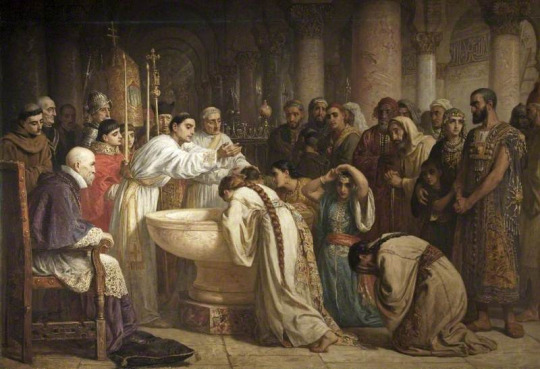
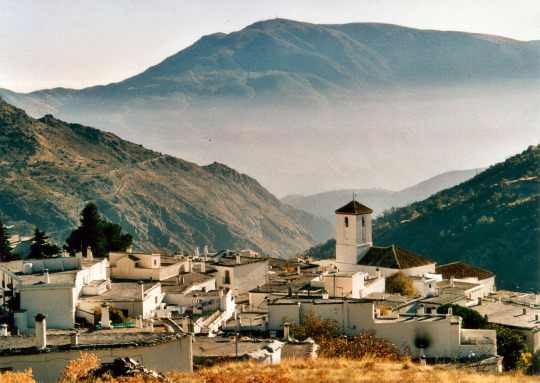
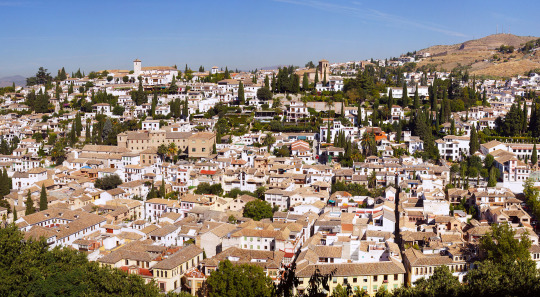
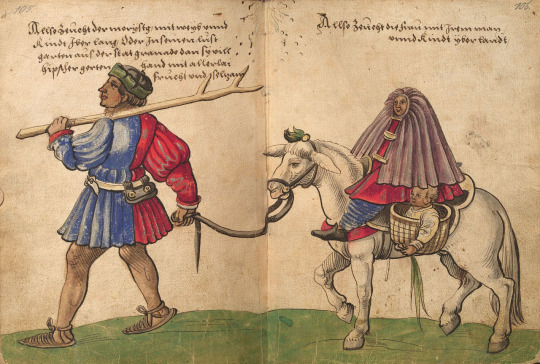
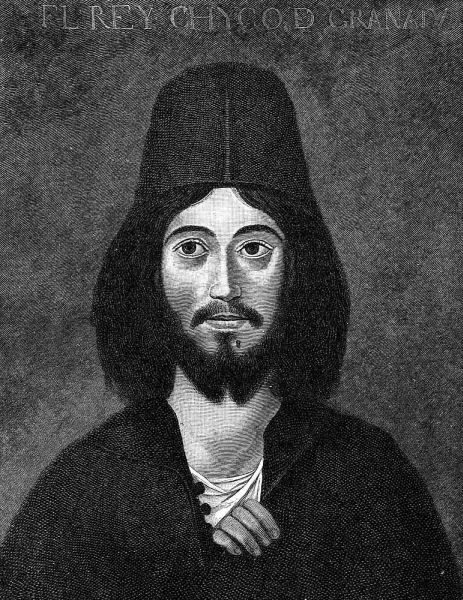
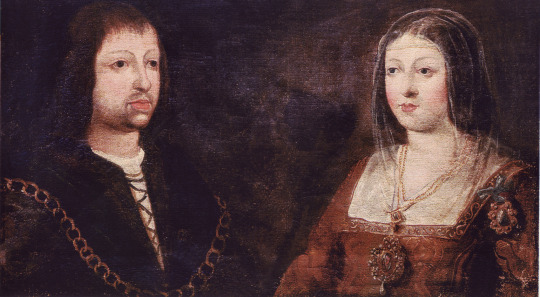
#Moors#morisco#spain#islamic history#islam#spanish inquisition#castile#aragon#portugal#navarre#granada#Emirate of Granada#cordoba#umayyad#Al andalus#military history#alpujarras#Guerilla Warfare#Middle Ages#reconquista#caliphate of cordoba#abbasid#catholic monarchs#ferdinand ii#isabella i of castile#1492#christopher columbus#morocco
5 notes
·
View notes
Video
youtube
A history of antisemitism (1/4)
Where did antisemitism begin, and how did it evolve? The first episode of this documentary series examines the roots of antisemitism, starting with the first wave of anti-Jewish violence in the year 38 in ancient Alexandria.
Why did the first major wave of anti-Jewish violence arise in Alexandria when the Romans took power? How did anti-Judaism take root in Christian and Muslim civilizations? After a 300-year Golden Age on the Iberian Peninsula, how did Granada become the scene of a massacre -- the first pogrom on European soil? Why did Jewish pogroms occur throughout the Crusades?
Part one of this four-part documentary walks viewers through the first millennium of this story. The film also examines early struggles to counter antisemitic hostilities: From the protection of the Jews offered by the Carolingians, to the support of the Moorish kings in Spain and the call put out by Abbot Bernard of Clairvaux (1090 - 1153) to put an end to the bloody persecution of Jews during the Crusades.
Part 1: https://youtu.be/Nq5cpbwsCpw
Part 2: https://youtu.be/680s2wpicwc
Part 3: https://youtu.be/8aes5ipvKB8
Part 4: https://youtu.be/xnZ_HQC1gBA
DW Documentary
#antisemitism#racism#religion#Judaism#Christianity#Islam#history#documentary#Deutsche Welle#Al Andalus#Middle East#Egypt#Roman Empire#Moorish#Crusades#Carolingian Empire#Granada#Spain#France#politics#discrimination#prejudice#erasure#violence#Arte France
10 notes
·
View notes
Text
Events 11.25 (before 1920)
571 BC – Servius Tullius, king of Rome, celebrates the first of his three triumphs for his victory over the Etruscans.
1034 – Máel Coluim mac Cináeda, King of Scots, dies. His grandson, Donnchad, son of Bethóc and Crínán of Dunkeld, inherits the throne.
1120 – The White Ship sinks in the English Channel, drowning William Adelin, son and heir of Henry I of England.
1177 – Baldwin IV of Jerusalem and Raynald of Châtillon defeat Saladin at the Battle of Montgisard.
1343 – A tsunami, caused by an earthquake in the Tyrrhenian Sea, devastates Naples and the Maritime Republic of Amalfi, among other places.
1400 – King Minkhaung I becomes king of Ava.
1487 – Elizabeth of York is crowned Queen of England.
1491 – The siege of Granada, the last Moorish stronghold in Spain, ends with the Treaty of Granada.
1510 – Portuguese conquest of Goa: Portuguese naval forces under the command of Afonso de Albuquerque, and local mercenaries working for privateer Timoji, seize Goa from the Bijapur Sultanate, resulting in 451 years of Portuguese colonial rule.
1596 – The Cudgel War begins in Finland (at the time part of Sweden), when peasants rebel against the imposition of taxes by the nobility.
1667 – A deadly earthquake rocks Shemakha in the Caucasus, killing 80,000 people.
1678 – Trunajaya rebellion: After a long and logistically challenging march, the allied Mataram and Dutch troops successfully assaulted the rebel stronghold of Kediri.
1755 – King Ferdinand VI of Spain grants royal protection to the Beaterio de la Compañia de Jesus, now known as the Congregation of the Religious of the Virgin Mary.
1758 – French and Indian War: British forces capture Fort Duquesne from French control. Later, Fort Pitt will be built nearby and grow into modern Pittsburgh.
1759 – An earthquake hits the Mediterranean destroying Beirut and Damascus and killing 30,000–40,000.
1783 – American Revolutionary War: The last British troops leave New York City three months after the signing of the Treaty of Paris.
1795 – Partitions of Poland: Stanisław August Poniatowski, the last king of independent Poland, is forced to abdicate and is exiled to Russia.
1826 – The Greek frigate Hellas arrives in Nafplion to become the first flagship of the Hellenic Navy.
1833 – A massive undersea earthquake, estimated magnitude between 8.7 and 9.2, rocks Sumatra, producing a massive tsunami all along the Indonesian coast.
1839 – A cyclone slams into south-eastern India. An estimated 300,000 deaths resulted from the disaster.
1863 – American Civil War: Battle of Missionary Ridge: Union forces led by General Ulysses S. Grant break the Siege of Chattanooga by routing Confederate troops under General Braxton Bragg at Missionary Ridge in Tennessee.
1864 – American Civil War: A group of Confederate operatives calling themselves the Confederate Army of Manhattan starts fires in more than 20 locations in an unsuccessful attempt to burn down New York City.
1874 – The United States Greenback Party is established as a political party consisting primarily of farmers affected by the Panic of 1873.
1876 – American Indian Wars: In retaliation for the American defeat at the Battle of the Little Bighorn, United States Army troops sack the sleeping village of Cheyenne Chief Dull Knife at the headwaters of the Powder River.
1905 – Prince Carl of Denmark arrives in Norway to become King Haakon VII of Norway.
1908 – A fire breaks out on SS Sardinia as it leaves Malta's Grand Harbour, resulting in the ship's grounding and the deaths of at least 118 people.
1912 – Românul de la Pind, the longest-running newspaper by and about Aromanians until World War II, ceases its publications.
1915 – Albert Einstein presents the field equations of general relativity to the Prussian Academy of Sciences.
1917 – World War I: German forces defeat Portuguese army of about 1,200 at Negomano on the border of modern-day Mozambique and Tanzania.
1918 – Vojvodina, formerly Austro-Hungarian crown land, proclaims its secession from Austria-Hungary to join the Kingdom of Serbia.
0 notes
Text
History and Culture of Spain
The Kingdom of Spain is a country whose territory is mostly located on the Iberian Peninsula, in the far south-west of Europe. It comprises a total area of 504,642 km² and includes territories on both the mainland peninsula and nearby islands, such as the Canary Islands and Balearic Islands, the cities of Ceuta and Melilla and the so-called Plazas de Soberanía [Places of Sovereignty] in North Africa.
Given its geographic location, Spain has experienced a rich and varied history. The first modern humans settled in what is now Spain over 35,000 years ago. The Roman conquest began in 218 BC and led to a far-reaching process of cultural assimilation, the repercussions of which continue to be felt today. Following the fall of the Western Empire, Hispania was conquered by Germanic tribes (Visigoths, Suevi and Vandals) and then by the Moors. The Moorish presence on the peninsula lasted until 1492 and the fall of the Nasrid Kingdom of Granada. The marriage of the Catholic Kings led to a dynastic union between the territories of the Crown of Castile and the Crown of Aragon. After the discovery and conquest of America, Spain became the leading powerhouse in Europe and formed a great empire that extended across four continents. The Spanish presence in America forged strong ties between the two shores of the Atlantic, with Spanish becoming a common language shared by over 500 million people.
At the present time, Spain forms part of the group of countries with the most advanced level of development. It plays an active role in the main international forums and organisations, such as the UN, NATO, the OECD and the G-20. Spain is also a Member State of the European Union, the leading trade bloc in the world, and maintains its firm commitment to further developing integration in Europe.
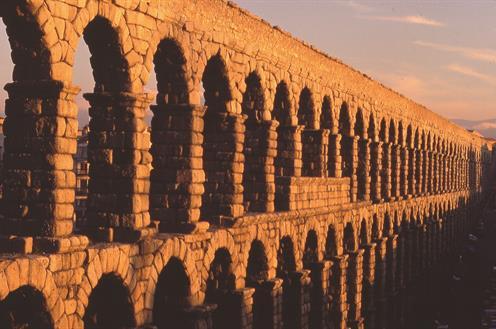
0 notes
Text
Porto - Day 3
Tuesday - 10/10
Our hotel is located at Batalha Square (Praca da Batalha). The square is named after a 10th-century battle fought between the Moors and the inhabitants of Porto, which resulted in the defeat of the inhabitants. The picture on the left shows a statue of King Pedro V in the square with our hotel in the left background. A tram used to run through this square in front of our hotel (picture on the right), but that tram line has been temporarily replaced by a bus route due to construction going on in other parts of the city.
Until the tram service is resumed, I am not sure I would stay at this hotel again. The hotel is located on the edge of the Porto main area on top of a hill, so every time you want to go somewhere you have to walk up and down hills. While it’s hard to avoid hills in Porto, I would choose a location that is more centrally located. I would consider checking out Porto bay Flores, which is recommended by Conde Nest Traveler and centrally located in Porto.
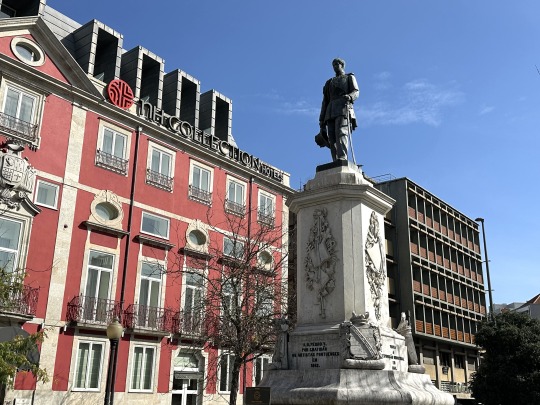

Our first stop today was to go to Porto Cathedral (Catedral do Porto). The cathedral was built in the 12th century. Note the blue tile on the right.


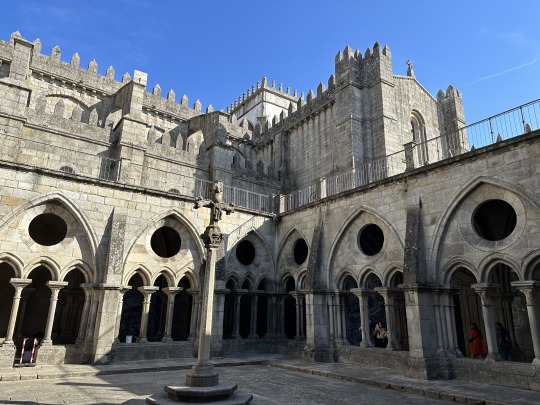

Next we bought food for a picnic lunch and started a walk. As we walked through the city we have seen a lot of street artists/performers in Porto.


We ultimately walked along the river for about 30 minutes and had lunch along the way. After lunch we went to the Tram Museum (Museu Carro Electrico). Porto first had horse drawn trams (picture on the left below), then steam trams and finally electric trams. Early electric trams had a catcher in the front to scoop up any people or animals in their way so the didn’t run over them (picture on the right below).


The pictures below show some of the specialized tram cars. The tram on the left moved baskets of fish within Porto and the tram on the right was used to transport coal.

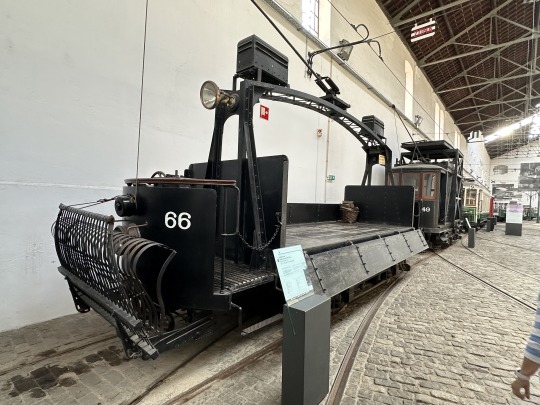
After the Tram Museum we took our first bus ride in Porto. Bus route 500 goes along the river back to the center of the city. Once there we went to Saint Francis Church (Igreja de Sao Francisco), which is Port’s only Gothic style church.
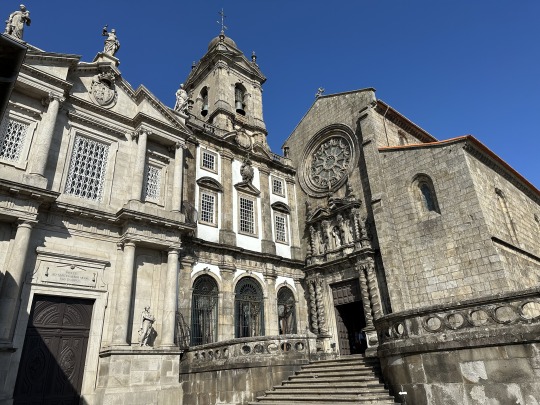

They didn’t allow any photos inside; the picture below is from the internet.

Next stop was the Stock Exchange Palace (Palácio da Bolsa). This was where the Portugal stock exchange was first located and now houses the Commercial Association of Porto. Taking a guided tour of the palace is very popular and we waited in a line for about 30 minutes earlier in the day to get tickets for a 5pm English speaking tour.

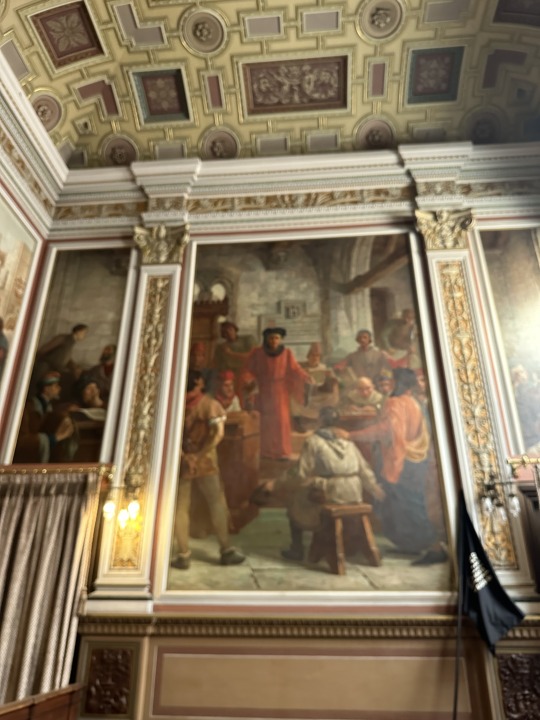

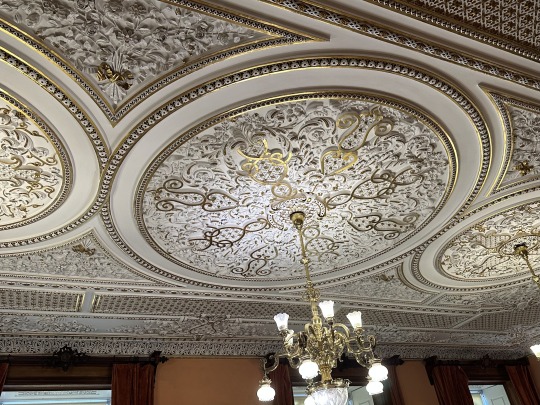

Below is Arabian Hall, which was inspired by Granada’s Alhambra and decorated in th Moorish style with wood, plaster and gold leaf. It took 18 years to build.

Afterwards we had dinner in the Majestic Cafe, a historical and luxurious coffeehouse/restaurant known for it architectural beauty that dates back to the 1920s.

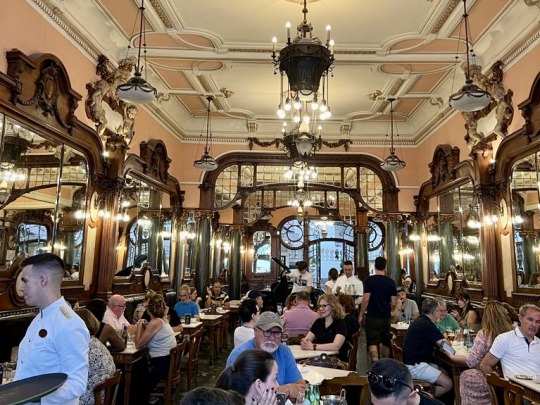
We shared a Francesinha and a club house sandwich. A Francesinha is a Portuguese sandwich, which originated in Porto, made with layers of toasted bread, steak, spiced sausage and ham, over which sliced cheese is melted and then covered with a warm tomato-and-beer sauce. It looks like a prescription for a heart attack, but tasted good.

After dinner we went window shopping on Rua de Santa Catarina.
0 notes
Text
Road Trip through Spain - Roadtrip durch Spanien

Source: Playa Montroig Camping Resort, Costa Dorada, Tarragona, Spain, [online] https://www.playamontroig.com/de/galeria
One of my older brothers loved to camp and traveled with his caravan to Spain almost every year from the 70s to the 90s. Over time, a campsite emerged that he and his wife particularly liked: Playa Montroig Camping Resort - about 140 km west of Barcelona. So in the mid 90s my younger brother and I packed my tent and camping gear into my beloved little Fiat Uno and headed towards Spain to experience this wondrous campsite for ourselves. After almost a week, however, we realized that a pure beach vacation is not really our thing - so we spontaneously packed everything up again and jetted further west: Valencia, Granada, Malaga/Marbella and Tarifa were our stops. From Tarifa we made trips to Gibraltar and even Tanger in Morocco (I set foot on African soil for the first and only time then).
But the highlight of the road trip for me was Granada and the visit to the Alhambra there (a Moorish fortress with a palace complex like in the fairy tales of 1001 Nights). Granada is located in the Spanish Sierra Nevada - the highest mountain range on the Iberian Peninsula. We spent the night there a bit off the road in our sleeping bags under the open sky and were rewarded with a fantastic sunrise the next morning. A few years before I saw the movie "El Cid" starring Charlton Heston and Sophia Loren about a medieval Spanish hero the Moorish called „El Cid“ (the master). The movie deals with the reconquest (Reconquista) of the Moorish areas of Spain by Christians. The Moors were Muslims, originally from North Africa, and were great patrons of science and art. They left beautiful buildings and parts of their high culture (e.g. use of spices) in Spain - and not only that: about 30% of the Spaniards have North African genes. The Reconquista lasted almost 800 years - i.e. large parts of Spain were owned by the Moors for a very long time. In 1492 the Reconquista ended with the surrender of the Alhambra fortress by the Moors to the Christians - so a place steeped in history! Moors and Jews living there were then forced to convert to Christianity or to leave the country. Today one would probably call it “ethnic displacement”. Another dark spot in European history.

Source: La rendicion de Granada (The Surrender of Granada), Francisco Pradilla Ortiz, 1882, Public Domain - in 1492, Boabdil, the last Moorish king of Granada, hands over his kingdom to the Spanish royal couple Ferdinand and Isabella.
-
Einer meiner älteren Brüder liebte es zu campen und reiste von den 70igern bis 90igern fast jedes Jahr mit seinem Wohnwagen nach Spanien. Mit der Zeit kristallisierte sich dabei ein Campingplatz heraus, den er und seine Frau besonders mochten: Playa Montroig Camping Resort - ca. 140 km westlich von Barcelona. Mitte der 90iger packten deshalb mein jüngerer Bruder und ich mein Zelt mitsamt Campingausrüstung in meinen innig geliebten, kleinen Fiat Uno und düsten in Richtung Spanien, um diesen wundersamen Campingplatz selbst zu erleben. Nach einer knappen Woche stellten wir jedoch fest, dass ein reiner Strandurlaub nicht ganz unser Ding ist - so packten wir spontan wieder alles zusammen und düsten weiter gen Westen: Valencia, Granada, Malaga/Marbella und Tarifa waren unsere Stationen. Von Tarifa aus unternahmen wir Trips nach Gibraltar und sogar Tanger in Marokko (ich betrat damals das erste und bisher einzige Mal afrikanischen Boden).
Das Highlight des Roadtrips war für mich jedoch Granada und der Besuch der dortigen Alhambra (eine maurische Festung mit Palastanlage wie aus den Märchen von 1001 Nacht). Granada liegt in der spanischen Sierra Nevada - dem höchsten Gebirge der iberischen Halbinsel. Wir übernachteten dort etwas abseits von der Strasse in unseren Schlafsäcken unter freiem Himmel und wurden mit einem fantastischen Sonnenaufgang am nächsten Morgen belohnt. Ein paar Jahre zuvor habe ich den Film „El Cid“ mit Charlton Heston und Sophia Loren über einen spanischen Helden des Mittelalters gesehen, den die Mauren „El Cid“ (den Meister) nannten. Der Film thematisiert die Rückeroberung (Reconquista) der von den Mauren besetzten Gebiete Spaniens durch die Christen. Die Mauren waren Muslime, stammten ursprünglich aus Nordafrika und waren grosse Förderer von Wissenschaft und Kunst. Sie liessen in Spanien wunderschöne Bauten und ein Teil ihrer hohen Kultur (z.B. Verwendung von Gewürzen) zurück - und nicht nur das: ca. 30% der Spanier haben nordafrikanische Gene. Die Reconquista dauerte fast 800 Jahre - d.h. grosse Teile Spaniens waren eine sehr lange Zeit in Besitz der Mauren. 1492 endete die Reconquista mit der Übergabe der Alhambra-Festung durch die Mauren an die Christen - also ein recht geschichtsträchtiger Ort! Mauren und dort lebende Juden wurden danach gezwungen zum Christentum zu konvertieren oder das Land zu verlassen. Heute würde man das wohl „ethnische Vertreibung“ nennen. Ein weiterer, dunkler Fleck europäischer Geschichte.
-Simplicius Simplicissimus
#traveling#reisen#spain#spanien#granada#alhambra#moors#christians#mauren#christen#reconquista#movies#filme#el cid
0 notes